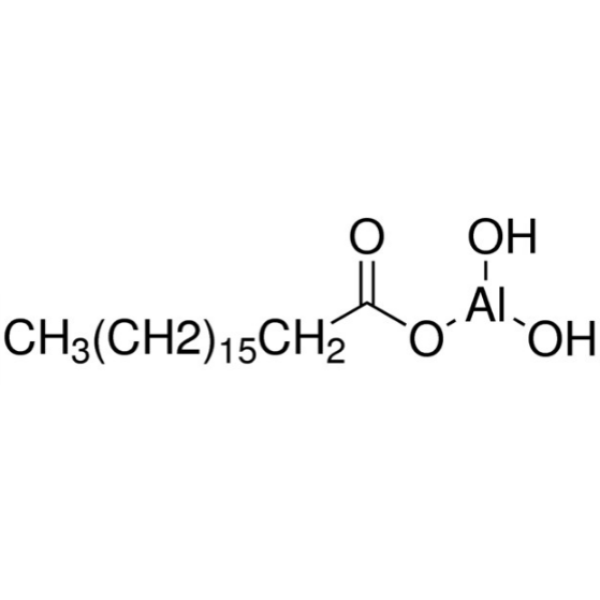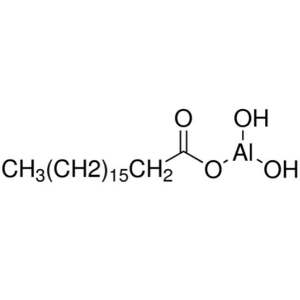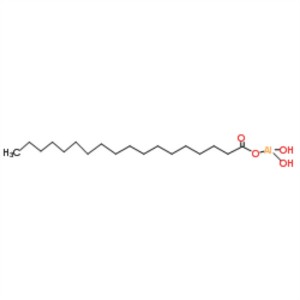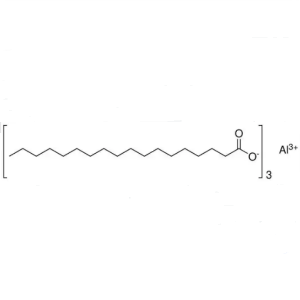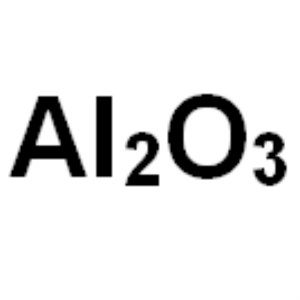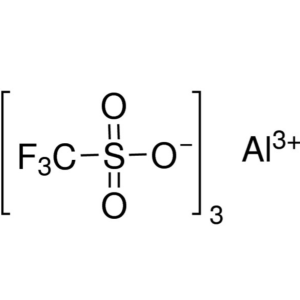Aluminum Monostearate CAS 7047-84-9 Assay (Al2O3) 14.5~16.5%
Shanghai Ruifu Chemical Co., Ltd. is the leading manufacturer of Aluminum Monostearate (CAS: 7047-84-9) with high quality. Ruifu Chemical can provide worldwide delivery, competitive price, excellent service, small and bulk quantities available. Purchase Aluminum Monostearate, Please contact: alvin@ruifuchem.com
| Chemical Name | Aluminum Monostearate |
| Synonyms | Aluminum Dihydroxide Stearate; Stearic Acid Aluminum Dihydroxide Salt; Dihydroxy(stearoyloxy)aluminum; Dihydroxyaluminium Stearate |
| Stock Status | In Stock, Commercial Production |
| CAS Number | 7047-84-9 |
| Molecular Formula | C18H37AlO4 |
| Molecular Weight | 344.47 g/mol |
| Melting Point | 155.0~162.0℃ |
| Density | 1.020 |
| Solubility | Practically Insoluble in Water. Soluble in Ethanol (95%) and Benzene |
| COA & MSDS | Available |
| Free Sample | Available |
| Origin | Shanghai, China |
| Brand | Ruifu Chemical |
| Items | Specifications | Results |
| Appearance | Fine, White to Yellowish-White Grainy Powder | Complies |
| Identification Aluminum | Meets NF Requirements | Pass |
| Identification Stearate | 54℃ Min | 64℃ |
| Loss on Drying | <2.00% | 1.75% |
| Heavy Metals (Pb) | ≤50ppm | <50ppm |
| Arsenic (As) | ≤4ppm | <4ppm |
| Assay (as Al2O3) | 14.5%~16.5% | 14.8% |
| Sieve Test NO.80 Silk Sieve | ≥90% Through | >90% |
| Conclusion | The product has been tested and complies with the given specifications | |
Package: Bottle, Aluminium foil bag, 5kg/25kg/Cardboard Drum, or according to customer's requirement.
Storage Condition: Keep the container tightly closed and store in a cool, dry and well-ventilated warehouse away from incompatible substances. It is stable under ordinary conditions of use and storage. Protect from light and moisture/water.
Shipping: Deliver to worldwide by air, by FedEx / DHL Express. Provide fast and reliable delivery.
Aluminum Monostearate
Dihydroxy(stearato)aluminum [7047-84-9].
Aluminum Monostearate is a compound of aluminum with a mixture of solid organic acids obtained from fats, and consists chiefly of variable proportions of aluminum monostearate and aluminum monopalmitate. It contains the equivalent of not less than 14.5 percent and not more than 16.5 percent of Al2O3, calculated on the dried basis.
Packaging and storage- Preserve in well-closed containers.
Identification-
A: Heat 1 g with a mixture of 25 mL of water and 5 mL of hydrochloric acid for 1 hour, replacing the water as it evaporates: fatty acids are liberated, floating as an oily layer on the surface of the liquid, and the water layer responds to the tests for Aluminum <191>.
B: Mix intimately 25 g with 100 mL of ether in a 500-mL flask, add 150 mL of 3 N hydrochloric acid, attach a water-cooled condenser, and heat on a steam bath under reflux for 15 minutes. Cool, and transfer both layers to a separator with the aid of an additional 100 mL of ether. Shake vigorously, and allow the layers to separate. Remove the water layer, and wash the ether layer with three 30-mL portions of water. Transfer the ether layer to a small beaker, warm on a steam bath until the ether has evaporated and the fatty acids are clear, and dry the acids at 105° for 20 minutes: the solidification temperature (see Fats and Fixed Oils 401) of the fatty acids is not below 54°.
Loss on drying <731>-Dry it at 80 for 16 hours: it loses not more than 2.0% of its weight.
Arsenic, Method I <211>-Prepare the Test Preparation as follows. To 3.75 g add 12.5 mL of hydrochloric acid and 0.5 mL of bromine TS, and heat on a steam bath until a transparent layer of melted fatty acid forms. Add 50 mL of water, heat on a hot plate until the volume is about 25 mL, and filter while hot. Cool, dilute the filtrate with water to 50 mL, and to a 10-mL aliquot of this solution add 2.5 mL of hydrochloric acid, then dilute with water to 55 mL: the resulting solution meets the requirements of the test, the addition of 20 mL of 7 N sulfuric acid specified for Procedure being omitted. The limit is 4 ppm.
Heavy metals-To 2 g contained in a 250-mL flask add 20 mL of water and 10 mL of hydrochloric acid. Place a small funnel in the neck of the flask, and boil gently, replacing the water as it evaporates, until the fatty acids separate in a clear layer. Cool rapidly by rotating under a stream of cold water until the fatty acids solidify. Decant through a filter previously washed with 3 N hydrochloric acid, wash until the combined filtrate and washings measure 50 mL, and mix. To 20 mL of the pooled filtrate add 6 N ammonium hydroxide, dropwise, until a permanent turbidity forms. Add 1 N acetic acid until the precipitate just dissolves, then add 2 mL in excess, and add water to make 40 mL. Add 1.2 mL of thioacetamide-glycerin base TS and 2 mL of pH 3.5 Acetate Buffer, and allow to stand for 5 minutes: any brown color produced is not darker than that of a control solution prepared from 10 mL of the pooled filtrate and 2 mL of Standard Lead Solution (see Heavy Metals <231>) containing 10 µg of lead per mL, then diluted with water to 20 mL and treated in the same manner. The limit is 50 µg per g.
Assay-Accurately weigh 5 g of Aluminum Monostearate in a covered platinum crucible that previously has been ignited for 20 minutes, cooled over anhydrous magnesium perchlorate, and weighed. Heat the open crucible gently, without allowing the specimen to burst into flame, and gradually increase the heat until the ash is white. Ignite the ash for 20 minutes after the organic matter is removed, and cool. Add 15 mL of water, cover the crucible with a small watch glass, and boil gently for 5 minutes, using a small stirring rod to break up any large lumps of ash. Decant the solution through ashless filter paper, retaining most of the ash in the crucible. Repeat the extraction with water twice, passing the solutions through the same filter. Transfer the ash to the filter by means of a fine stream of water, and wash the crucible and the residue three times with warm water. Transfer the filter paper and the residue to the crucible, dry, and ignite for 20 minutes after the filter paper has burned away. Following the ignition period, cover the crucible, cool over anhydrous magnesium perchlorate for 15 minutes, and weigh the residue of Al2O3 rapidly. Repeat the ignition until constant weight is attained, using 20-minute ignition periods and 15-minute cooling periods. From the weight of the residue remaining in the crucible, calculate the content of Al2O3.
How to Purchase? Please contact Dr. Alvin Huang: sales@ruifuchem.com or alvin@ruifuchem.com
15 Years Experience? We have more than 15 years of experience in the manufacture and export of a wide range of high quality pharmaceutical intermediates or fine chemicals.
Main Markets? Sell to domestic market, North America, Europe, India, Korea, Japanese, Australia, etc.
Advantages? Superior quality, affordable price, professional services and technical support, fast delivery.
Quality Assurance? Strict quality control system. Professional equipment for analysis include NMR, LC-MS, GC, HPLC, ICP-MS, UV, IR, OR, K.F, ROI, LOD, MP, Clarity, Solubility, Microbial limit test, etc.
Samples? Most products provide free samples for quality evaluation, shipping cost should be paid by customers.
Factory Audit? Factory audit welcome. Please make an appointment in advance.
MOQ? No MOQ. Small order is acceptable.
Delivery Time? If within stock, three days delivery guaranteed.
Transportation? By Express (FedEx, DHL), by Air, by Sea.
Documents? After sales service: COA, MOA, ROS, MSDS, etc. can be provided.
Custom Synthesis? Can provide custom synthesis services to best fit your research needs.
Payment Terms? Proforma invoice will be sent first after confirmation of order, enclosed our bank information. Payment by T/T (Telex Transfer), PayPal, Western Union, etc.
| WGK Germany | 3 |
| RTECS | BD0707000 |
Aluminum Monostearate (CAS: 7047-84-9), fine, white to yellowish-white powder; faint characteristic odor. Insoluble in water, alcohol, and ether. Forms a gel with aliphatic and aromatic hydrocarbons.
Aluminum Monostearate is an aluminum compound of stearic acid and palmitic acid. The USP32-NF27 states that Aluminum Monostearate contains the equivalent of not less than 14.5% and not more than 16.5% of Al2O3, calculated on the dried basis. The JP XV states that it contains not less than 7.2% and not more than 8.9% of aluminium. Aluminum monostearate occurs as a white, fine, bulky powder with a slight odor of fatty acid. It is a solid material.
Aluminum Monostearate (CAS: 7047-84-9) can be used in paints, inks, greases, waxes, thickening lubricating oils; waterproofing, gloss producer, stabilizer for plastics, food additive.
Used for the packaging of pharmaceuticals, and in the preparation of colors for cosmetics.
Aluminum Monostearate is used as a surfactant with excellent lubrication, rust prevention, emulsification, dispersion, thickening, defoaming performance.
Typical use: as emulsifier, dispersant application. application as a thickener. application as a lubricant. application as Defoamer. Personal care products are used as anti-caking agents, emulsion stabilizers, pigments, viscosity control agents, etc. Mechanical: as a rust inhibitor, etc., used in the field of metal processing. capable of thickening mineral oil. The anti-rust ability is lower than that of aluminum tristearate and aluminum distearate. Plastic as a heat stabilizer, lubricant and other applications. as anti-caking agent, emulsion stabilizer and other applications. as a suspending agent, matting agent, etc., used in the coating industry. Textile application as textile waterproofing agent. Cement: is used as a cement additive (waterproof additive).
Aluminum Monostearate (CAS: 7047-84-9) is prepared by reacting Aluminum with Stearic Acid.
Aluminum Monostearate (CAS: 7047-84-9) is mainly used in microencapsulation and in the manufacture of ointments. Aluminum Monostearate is used as a viscosity-increasing agent in nonaqueous cosmetic and pharmaceutical formulations. In addition, Aluminum Monostearate can be used as an emulsion stabilizer in cosmetic emulsions and is used in cosmetics such as mascara, moisturizers, and sunscreens.
A nuisance dust. When heated to decomposition it emits acrid smoke and fumes. See also ALUMINUM COMPOUNDS.
Aluminum Monostearate is generally regarded as relatively nontoxic and nonirritant when used as an excipient.
Aluminum Monostearate should be stored in a well-closed container in a cool, dry, place. It is stable under ordinary conditions of use and storage.
Aluminum Monostearate and Aluminum Stearate are included in the FDA Inactive Ingredients Database (oral capsules and tablets, topical creams and ointments). Included in nonparenteral medicines licensed in the UK.

